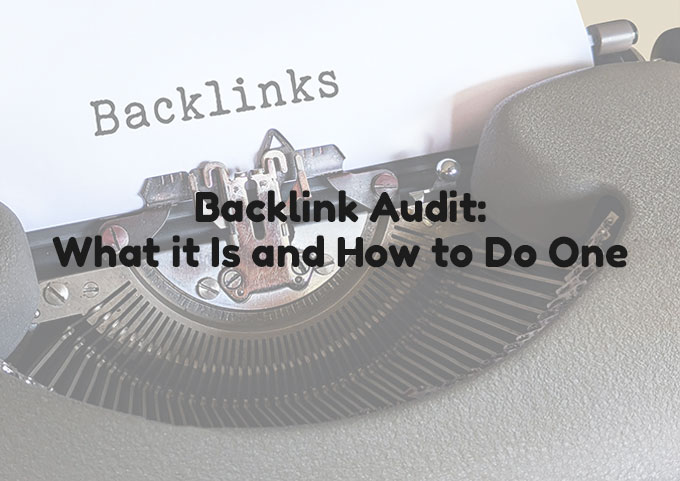
Backlinks are the foundation of a great website that ranks well. Even in 2023, after numerous Google algorithm updates and changes, backlinks remain one of the strongest ranking signals. And if you want to build a website that performs well in search, staying on top of your backlinks is a must.
The best starting point for any website is doing a backlink audit.
What is a backlink audit?
A backlink audit is the process of looking into links pointing to your website. In the audit process, you analyze:
- The total number of links you have
- Where the links are coming from
- What pages the links are pointing to
- The quality of the websites linking to you
- The relevance of the backlinks for your website and business
- The changes in inbound links over time
Whether you want to improve your SEO efforts or start new link building campaigns, an audit is the first step to get there. Only by knowing which links you already have can you make a good effort to build new and better ones to your website.
An audit can also tell you if your website has toxic backlinks pointing to it, or links pointing to the wrong pages. It’s also an easy way to see if your link building cost is bringing value to your marketing efforts, or if your agency or freelancer is building cheap, nofollow links.
How to do a backlink audit in just a few simple steps
Even if you don’t have an SEO expert on your team and no previous SEO experience, you can do a simple but effective backlink audit. Here are the step-by-step instructions on how to get there without breaking a sweat, build some links and acquire new search traffic.
Step 1: get an SEO tool with backlink audit capabilities
In the SEO arena, there are quite a few tools that help with on- and off-page search engine optimization. The two contenders for the throne are Ahrefs and SEMRush.
If you want to do a backlink audit, grabbing either of these is a great starting point. Both are highly capable tools that do a variety of tasks besides backlink audits. Keyword research, competitor gap analysis, organic search performance tracking – these are just some of the many things these tools can do.
The only real difference is that Ahrefs is a bit on the pricier side, given its most recent pricing changes. Meanwhile, SEMRush has a pretty flat pricing structure so you know what you’re paying and what you’re going to get. There is also Moz, which is an outdated but still good choice.
At ReportCard, we use Ahrefs as our tool of choice. This is why we’ll walk you through the rest of the steps using Ahrefs.
Step 2: Assess your current backlink profile
Simply load up your website’s URL in the Ahrefs Site Explorer. Just the homepage and nothing else.
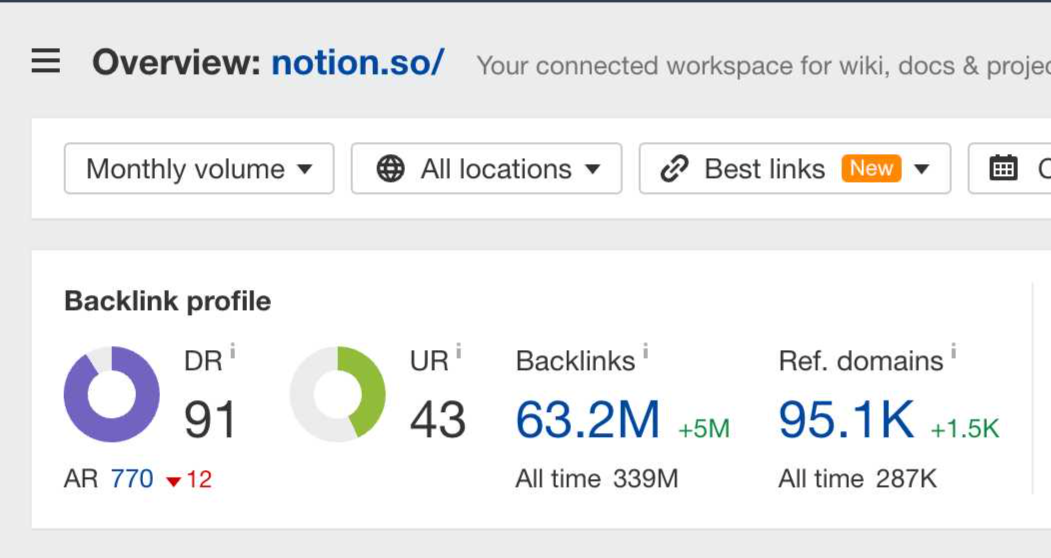
For example, here is how the backlink profile looks for Notion.so – a whopping 63 million link from 95k domains.
At a glance, you’ll also be able to see your key metrics from this backlink checker: number of referring domains and backlinks. The referring domains are the unique websites that link to you, while backlinks represent the total number of backlinks.
On its own, this data won’t tell you too much about your backlink portfolio and search engine performance. For example, you won’t know if these are bad links from poor domain authority websites. However, it’s a necessary starting point and a basis for comparison.
Step 3: Compare your performance against the competition at a glance
The main overview of your backlinks in Ahrefs is a quick way to determine how your backlink profile looks when compared to your biggest competitors. Tools such as Ahrefs are amazing because unlike Google Analytics, they give you a glimpse of your competitors’ performance.
Here is an example of a competitor to Notion, whose backlinks we took a look at. This is the backlink profile for Clickup.com:
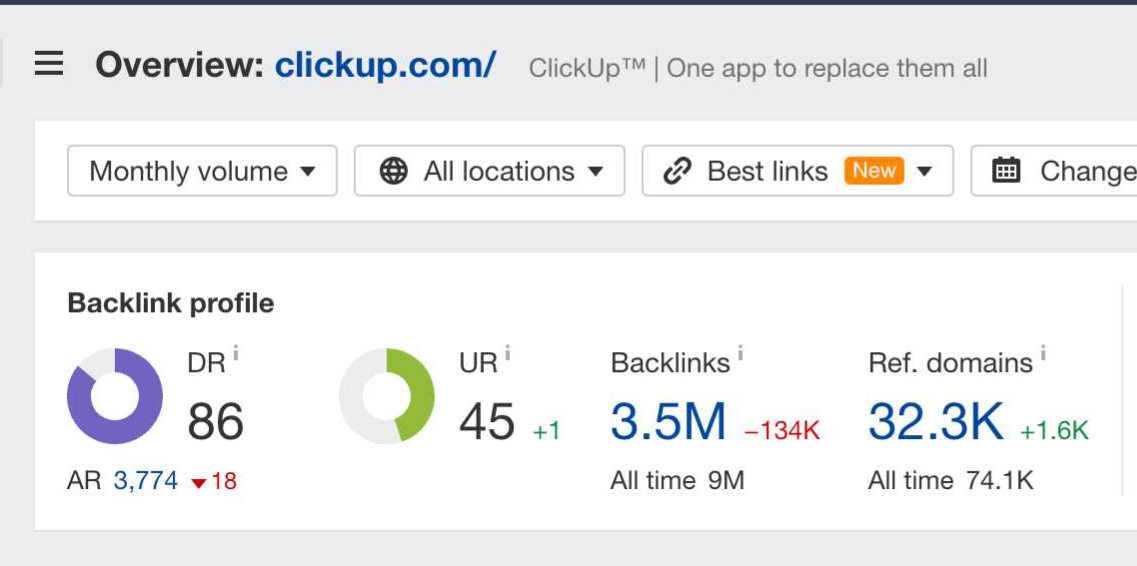
Just at a glance, we can see that Notion has a healthier number of backlinks and that recently, they have been growing too. However, you really want to take a look at referring domains. This is the number of unique websites linking back to yours.
In this case, 32k for Clickup against 95k for Notion does not look as bad as 3.5 million Clickup links against 63 million Notion backlinks.
When you compare your website against competitors, you want to ensure that your referring domains are growing at a steady pace. You can do this at a glance instead of looking at a full list of backlinks.
But taking a look at just numbers without considering other factors would be dangerous. Having a large number of low-quality links won’t move the needle and give your website any link juice. This is why we need to dig deeper.
Step 4: Take a look at your link acquisition over time
In Ahrefs, you can take a look at your domain and research the process you’ve used to accumulate links. Simply click on the “backlink profile” tab in Ahrefs to get a historical overview of link acquisition.
For Notion.so, that looks a bit like this:
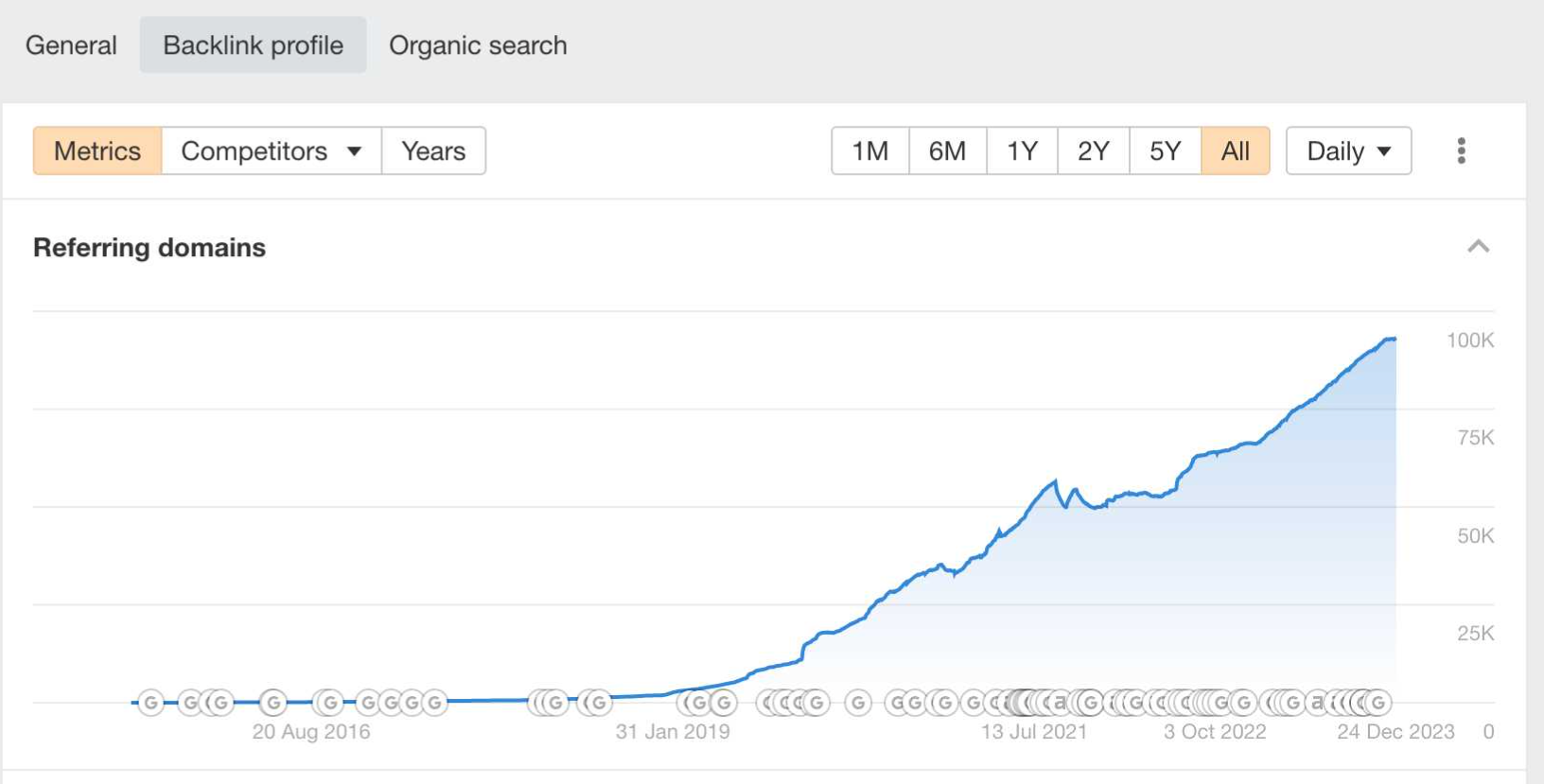
This is a healthy rate of growing backlinks to your website.
You want to watch out for inconsistencies – sudden spikes in either direction. A huge growth in backlinks at once could be a result of a major PR/link building campaign that grew backlinks rapidly.
More commonly though, spikes of any kind signal negative SEO attacks that reflect on search engine results or SERPs.
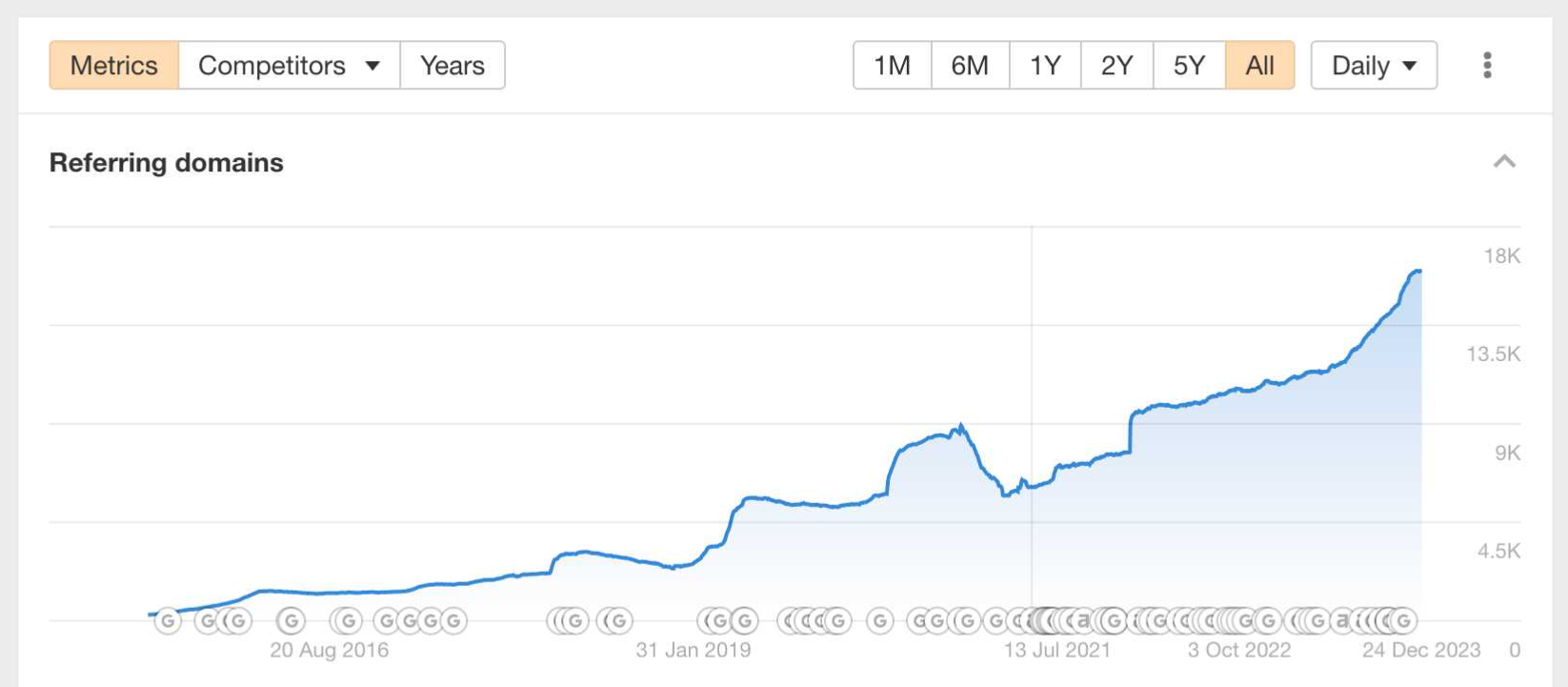
Here is an example of a website that got a big spike, and then took a hit and lost about 5,000 referring domains in a month.
There is no ideal rate of backlinks coming in over time. However, you want to look for natural growth without sudden movements up or down. If you get a sudden rush of backlinks, search engines can interpret it as a form of manipulation and you may be hit with manual actions, such as a Google penalty.
You can do something about it – you can disavow links in Google Search Console. Just add the websites you want in your disavow file and Google will ignore them.
Step 5: Review your top-level domains
A top-level domain or TLD is the last part of your URL. For example, in notion.so, the TLD is the “.so” part. Most common TLDs include .com, .net, .org, .co, .io and others.
In the case of Notion, this is what the breakdown looks like:
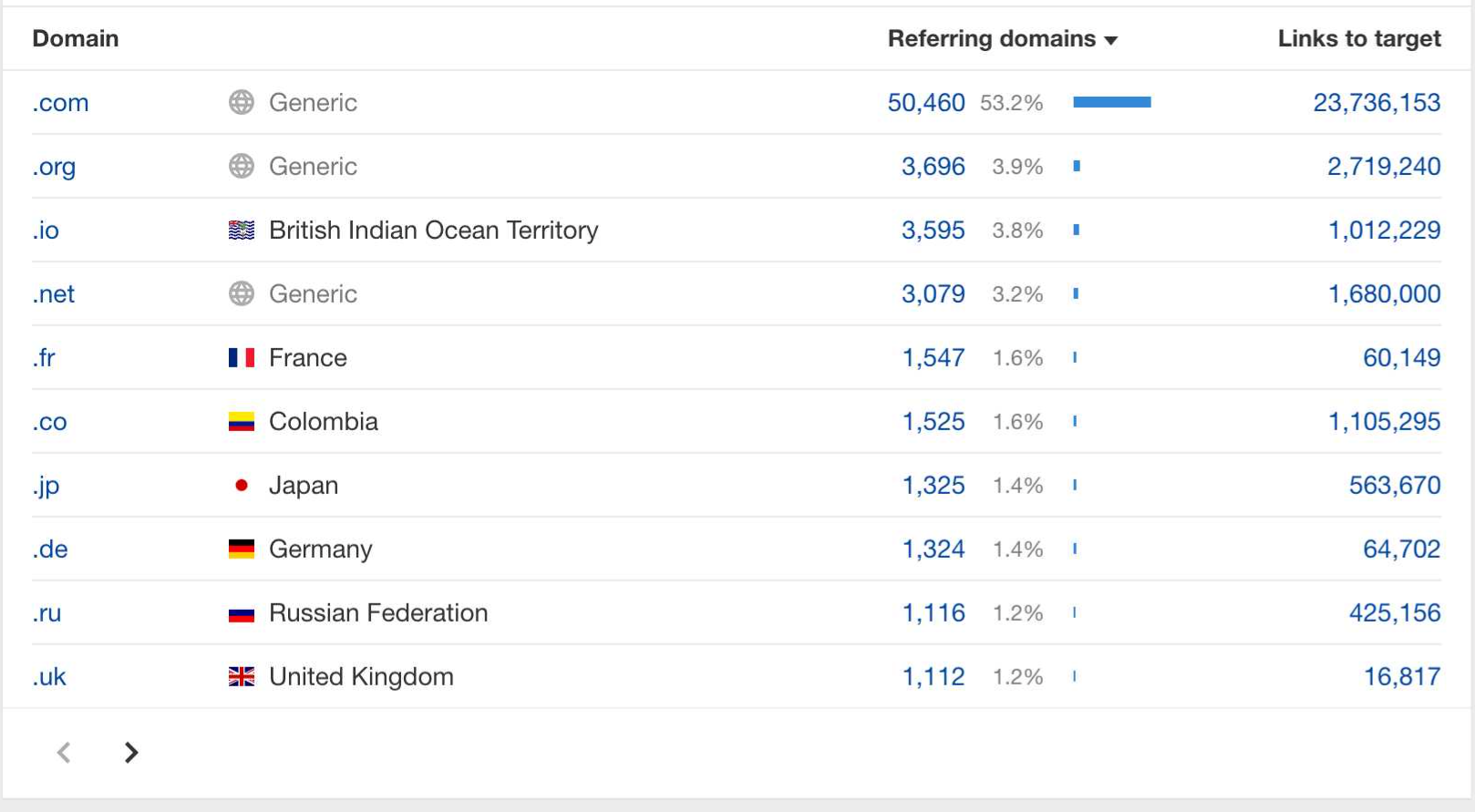
This is a pretty natural overview, with .com and other generic TLDs making up the most of backlinks. No TLD is considered “best” by default – there are many other things at play, such as authority score and relevance.
You want to look out for cases when your website has an unusually high percentage of a certain TLD. For example, .cn, .tk, .info and similar. These could be artificial, spammy backlinks built as a part of a negative SEO attack on your website.
Also, if you’re located in a certain country, you’re naturally going to have more links from that area. A Japan-based business is bound to have a large portion of .jp TLD backlinks.
Step 6: Review your anchor text
When someone links back to you, they use a certain word or a string of words to add the link. This is something called anchor text and in the world of SEO, it’s very important. In Ahrefs (and similar tools), you can take a look at the breakdown of anchor text across your links.
Here is what that looks like for our example:
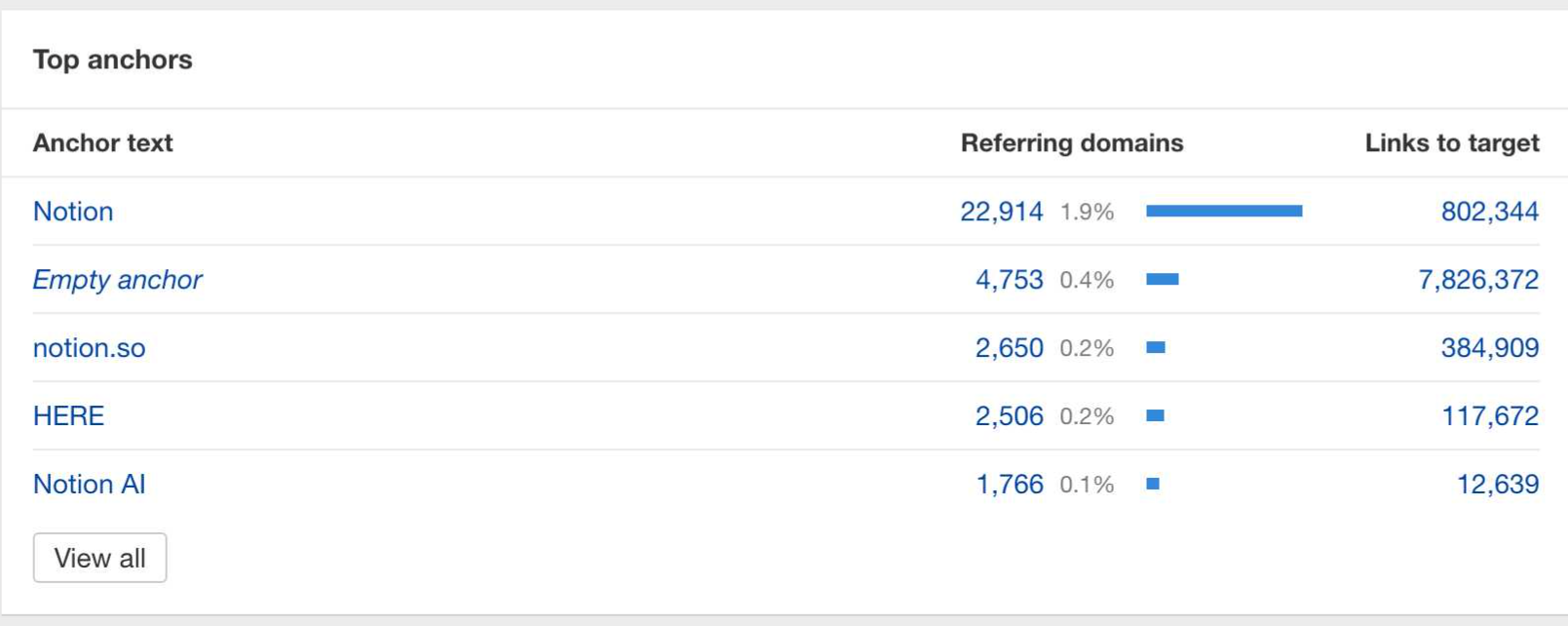
We see that the majority of backlinks have branded anchors. In other words, someone used the brand name and linked to the website, probably the home page. This is what the top anchors should look like for a healthy backlink portfolio. These are most commonly earned mentions and not paid links.
Your backlinks should have a good mix of branded anchors and those relevant to your business. Watch out for irrelevant text, branded anchors for other businesses, obscenities and similar terms that signify spammy links.
Journalists from platforms such as HARO will most commonly link to your homepage and add your brand name as an anchor, so you don’t have much say in these links.
You can then go to your Google Search Console and disavow any links that do more harm than good for your SEO progress.
Step 7: Review your broken backlinks
One common link building strategy is reclaiming broken backlinks. A backlink audit tool such as Ahrefs can let you access these with one click. In the backlink tab on the left, simply head to broken backlinks, and you’ll see the links you’ve had and lost over time.
For some reason, the webmaster or editor on a website removed these backlinks to your website in the past. If you’ve built these links manually, it’s a good idea to go through this list and do some outreach, asking to add those links once again.
A loss of backlinks over time isn’t necessarily bad. However, it’s good to do a backlink analysis every now and then to see why those links are getting removed.
One important aspect of this strategy is that you can use it to reclaim competitors’ backlinks. As a competitor’s backlink gets removed, you can offer the webmaster an alternative to your own website.
This is why it’s important to keep an eye on your broken links. They aren’t inherently harmful, but a competitor can reclaim a broken link to your website. Being informed of this link data can help your search engine rankings and improve the SEO performance of your website.
Step 8: Get an overview of your best pages by backlinks
One way to assess your link profile is to take a look at your own site and examine the linked pages that get the most backlinks. In Ahrefs, you can do that by heading to Pages on the left and selecting “Best by links” to view your top site’s backlinks.
This will show you the web pages that have the most backlinks pointing to them. This can help you with new digital marketing and content marketing efforts as you’ll know which content attracts backlinks.
Also, you’ll get a good idea of which pages have a large number of toxic links halting your progress. Last but not least, you can get in touch with websites pointing to low-quality pages of yours and ask them to link to those which are more relevant for your SEO success.
Wrapping up
Doing a backlink audit is a must for everyone who uses SEO and organic traffic as a channel for acquiring new customers. It can not only help you identify bad backlinks, but also find new opportunities to land high-quality backlinks.
If you’re struggling with collecting and interpreting backlink data, as well as building high-quality links, we can help. At ReportCard, we build hundreds of great links for our clients every month. We can not only analyze your backlink profile, but also build quality dofollow links to your website.
Book a free call to find out how we can help!



